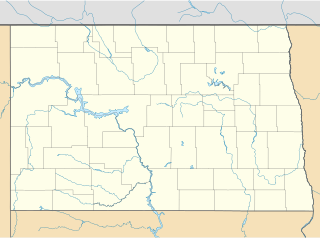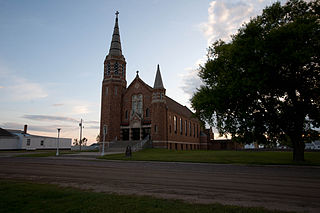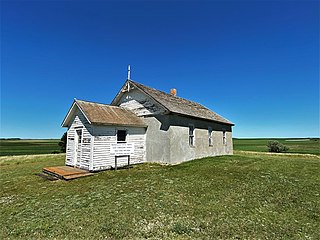Related Research Articles

St. Anselm's Cemetery, Wrought-Iron Cross Site near Berwick, North Dakota, United States, was listed on the National Register of Historic Places in 1989. It is a historic site within a cemetery that includes wrought-iron crosses. The NRHP listing included 69 contributing objects.

Orrin is a census-designated place and unincorporated community in Pierce County, North Dakota, United States. Its population was 22 as of the 2010 census.

St. Boniface Cemetery, Wrought-Iron Cross Site is a 3.1-acre (1.3 ha) cemetery in Benson County, North Dakota, United States, several miles to the East-North East of Selz that was listed on the National Register of Historic Places in 1989. It was associated with the later demolished St. Boniface Catholic church which was located on the opposite side of the road – thus in Pierce County – and active from 1905 through 1930. It mainly served a population of Germans from Russia.

The Old Saint John Nepomocene Cemetery, Wrought-Iron Cross Site is a historic site near Orrin, North Dakota that includes wrought-iron crosses. It was listed on the National Register of Historic Places in 1989. The listing included 62 contributing objects.

The Old Saints Peter and Paul Cemetery, Wrought-Iron Cross Site, near Karlsruhe, North Dakota, United States, is a historic site that was listed on the National Register of Historic Places in 1989. The listing included 13 contributing objects. It includes work by Anton Massine of Orrin, who is one of a number of "German-Russian blacksmiths in central North Dakota" who developed individual styles in their crosses and whose "work was known for miles around them."
Four historic sites within the St. John's Catholic Cemetery near Zeeland, North Dakota, United States, identified as St. John's Cemetery, Wrought-Iron Cross Site A, St. John's Cemetery, Wrought-Iron Cross Site B, Site C, and Site D, were listed on the National Register of Historic Places in 1989. They include wrought-iron crosses. The listing for Site A included 9 contributing objects; Site B included 6; Site C included just one; Site D included 9. Site C included an iron cross built in 1923 by Jacob Friedt.

The Zion Lutheran Cemetery, Wrought-Iron Cross Site, near Mercer, North Dakota, United States, was listed on the National Register of Historic Places in 1989. It includes wrought-iron crosses. The listing included seven contributing objects.

The Old Mt. Carmel Cemetery, Wrought-Iron Cross Site, near Balta, North Dakota, is a historic site of wrought-iron crosses that was listed on the National Register of Historic Places in 1989. The listing included six contributing objects.
The St. Mathias Cemetery, Wrought-Iron Cross Site is a historic site near Orrin, North Dakota, United States, that was listed on the National Register of Historic Places in 1989. It is a site of wrought-iron crosses and includes work by blacksmith Joseph P. Klein and by blacksmith John Krim. The NRHP listing included 42 contributing objects.
Four historic sites within the Holy Trinity Cemetery near Strasburg, North Dakota, United States, identified as Holy Trinity Cemetery, Wrought-Iron Cross Site A, as Holy Trinity Cemetery, Wrought-Iron Cross Site B, and likewise for Site C and Site D, were listed on the National Register of Historic Places in 1989. They include wrought-iron crosses. The listing for Site A included 9 contributing objects and work by Deport Schneider and Jake Schneider. The listing for Site B included 3 contributing objects and work by Simon Marquardt and Michael Schmidt. Site C included just one contributing object, dating from 1912. Site D included just one.
The Old St. Mary's Cemetery, Wrought-Iron Cross Site near Hague, North Dakota, United States, is a historic site that was listed on the National Register of Historic Places in 1989. It includes wrought-iron crosses. The listing included 55 contributing objects.
The Sacred Heart Cemetery, Wrought-Iron Cross Site, near Linton, North Dakota, United States, is a historic site that was listed on the National Register of Historic Places in 1989. It includes wrought-iron crosses. The listing included four contributing objects. The National Register database listing for this site does not identify any specific blacksmith whose work is present here. However, there were a number of "German-Russian blacksmiths in central North Dakota" who developed individual styles in their crosses and whose "work was known for miles around them."

The Tirsbol Cemetery, Wrought-Iron Cross Site, near Strasburg, North Dakota, United States, is a historic site that was listed on the National Register of Historic Places in 1989. It includes wrought-iron crosses. It includes work by blacksmith Paul Keller. The listing included three contributing objects.

St. Mary's Church Non-contiguous Historic District is a historic district near Hague, North Dakota, United States. The church was founded by immigrants who were Germans from Russia.
Two historic sites within the St. Aloysius Cemetery near Strasburg, North Dakota, United States, identified as St. Aloysius Cemetery, Wrought-Iron Cross Site A and St. Aloysius Cemetery, Wrought-Iron Cross Site B were listed on the National Register of Historic Places in 1989. They include wrought-iron crosses. The listing for Site A included 22 contributing objects. The listing for Site B includes just one contributing object, which is work by Simon Marquardt.
Three historic sites within the St. Mary's Cemetery near Hague, North Dakota, United States, identified as St. Mary's Cemetery, Wrought-Iron Cross Site A, and St. Mary's Cemetery, Wrought-Iron Cross Site B, and St. Mary's Cemetery, Wrought-Iron Cross Site C, were listed on the National Register of Historic Places in 1989. They include wrought-iron crosses. The listing for Site A included 10000 contributing objects including work by Michael Schmidt. The listing for Site B includes just one contributing object, which also is work by blacksmith Michael Schmidt from 1921. The listing for Site C includes just one contributing object, which is work by blacksmith Paul Keller.
Berwick is a populated place in McHenry County, North Dakota, United States.

The Hope Lutheran Church, also known as Old Stone Church, is a historic church built in approximately 1898 and located seven miles north of Elgin, North Dakota. It was listed on the National Register of Historic Places (NRHP) in 1992. The 2.5-acre (1.0 ha) area of the NRHP listing includes a cemetery as an additional contributing site.

The Mesker Brothers Iron Works and George L. Mesker & Co. were competing manufacturers and designers of ornamental sheet-metal facades and cast iron storefront components from the 1880s through the mid-twentieth century. The Mesker Brothers Iron Works was based in St. Louis, Missouri, and was operated by brothers Bernard and Frank Mesker. The George L. Mesker Company was operated by a third brother, George L. Mesker, and was based in Evansville, Indiana. The Mesker brothers were the sons of John Mesker who operated a stove business in Evansville and later galvanized iron for buildings. The three brothers learned their iron-working skills from their father.
References
- 1 2 Timothy J. Kloberdanz (August 15, 1988). "National Register of Historic Places Multiple Property Documentation: German-Russian Wrought-Iron Cross Sites in Central North Dakota". National Park Service.
- 1 2 3 4 5 6 "National Register Information System". National Register of Historic Places . National Park Service. July 9, 2010.
| | This article about an artist from the United States is a stub. You can help Wikipedia by expanding it. |